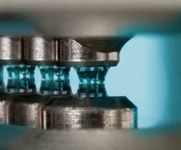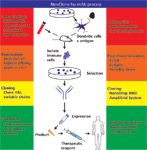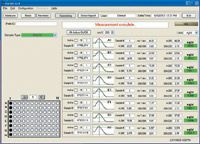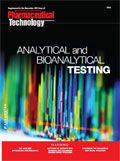A Novel Process for Developing Fully Human Monoclonal Antibodies
The authors describe a process for generating high affinity, fully human antibodies in culture.
Monoclonal antibodies (mAbs) are a rapidly growing class of human therapeutics representing approximately 25% of drugs under development (1). By 2014, 34 therapeutic mAbs are predicted to be on the market for treating cancer, autoimmune diseases, and infectious diseases (1). The commercial market for therapeutic mAbs grew to $32 billion in 2008, and is expected to reach $58 billion by 2014 (1).

PHOTO COURTESY OF THERMO FISHER
Since their discovery in 1975, mAbs have been described as "magic bullets" with the potential to seek out and bind targets with high affinity and specificity (2). The potential of using mAbs to treat human disease was immediately apparent. Early treatment efforts using rodent systems to develop mAbs for use in humans proved ineffective because of the strong immune responses they elicited in humans, limiting their half-life in the body and potentially causing anaphylaxis (3–5). Strategies to overcome this obstacle have included humanization of rodent-derived mAbs and development of fully human mAbs (hu-mAbs).
Currently, there are 27 mAb therapeutics on the market, and mAbs account for more than 25% of the drugs in the FDA pipeline and approximately 50% of all new drug launches (6, 7). Despite significant promise as therapeutic agents, many challenges potentially block mAbs' successful clinical implementation, including low affinities of mAbs for their targets, allergic reactions to mAbs, and high clearance rates. To address these challenges, there is a need to develop new therapeutic mAbs that are fully human. Hu-mAbs advance through clinical trials quickly because of their high specificity and typically predictable toxicity (1). Murine antibodies previously used as therapeutics (e.g., Johnson and Johnson's Orthoclone OKT3) had to be withdrawn from the market because of immunogenicity issues, short half-life, and side effects. Humanized mAbs, such as Genetech/Roche's Herceptin, and hu-mAbs, such as Abbott's Humira, are clearly the more desirable antibody therapeutics.
Methods for fully human antibody development
Several technologies exist for developing hu-mAbs, including:
- Complementarity-determining region (CDR) engraftment: This method entails preparation of a cDNA library, amplification of immunoglobulin (Ig) CDRs from a mouse hybridoma cell line, and engineering these sequences into the human variable light and heavy chain framework (8-10).
- Use of transgenic mice with human Ig genes: This method uses traditional hybridoma fusion techniques or molecular techniques to produce hu-mAbs (2). The transgenic mice have lost endogenous murine Ig production, and instead express DNA encoding human Ig genes (11–17). An immunized transgenic mouse is induced to develop an antigen-specific human immune response. Its B cells are then isolated and fused with a myeloma cell line to produce a mouse hybridoma that secrets a hu-mAb.
- Display technologies such as phage, yeast, and ribosome: These methods rely upon selection of desired binding characteristics of a particular antibody or scaffold protein expressed on the surface of a bacteriophage or other format (e.g., yeast cell or mammalian cell) and recovery of the encoding genes (10).
Current technologies for hu-mAb development are suboptimal in that the therapeutics derived from these approaches are either not fully human, resulting in increased human antimouse immune response, or require several rounds of maturation to achieve high affinity. The high cost of developing fully hu-mAbs using these available technologies, prevents many therapeutics researchers from employing them in preclinical testing against novel targets.
A reactivation strategy has been developed by Neoclone Biotechnology for generating fully human mAbs (see Figure 1). The technology employs in vitro culturing of immunized, specially-selected splenocytes with cytokines and low levels of antigen (Ag). This reactivation process yields affinity-matured, class-switched B cells. NeoClone has already developed and commercialized a murine mAb technology that employs in vitro reactivation for the custom mouse mAb market and is currently testing a novel hu-mAb development technology using therapeutically relevant cancer Ags.

Figure 1: Method for production of fully human monoclonal antibodies.
NeoAb approach to therapeutic antibodies
Neoclone's hu-mAb platform (which has been marketed under the NeoAb process) offers certain advantages:
- The mAbs are fully human, having been developed from human immune cells.
- The approach does not require immunizing patients or access to convalescent blood, therefore, the platform is amenable for mAb development using de novo immunization against any therapeutic target.
- mAbs developed using this approach will likely have higher affinities than Abs generated by library-based methods because reactivation focuses on selection of affinity-matured cell targets that proliferate in very low Ag levels.
- hu-mAbs generated using the NeoAb process can have fully-human glycosylation patterns, a distinct advantage over human mAbs expressed in non-human cells (18).
- The process enables selection for or against certain secondary characteristics such as Ab-dependent cellular cytotoxicity or complement-dependent cytotoxicity (19).
The NeoClone human mAb process can be divided into four stages: immunization, reactivation, cloning, and expression (see Figure 1).
Immunization: de novo immunization of human peripheral blood lymphocytes (PBL) in a SCID mouse model. NeoClone's current protocols for generating a human immune response to targeted antigens are based on published SCID-huPBL engraftment models (20–25) coupled with modifications of Ag-pulsed dendritic cell (DC) immunizations and multimer-linked Ag complex immunizations. The SCID-huPBL model repopulates immune deficient mice with human peripheral blood lymphocytes. SCID mice cannot make mature, antigen-specific B and T cells. Engraftment of human PBLs repopulates secondary lymphoid organs such as lymph nodes and spleen with human immune cells. Because of the enrichment process used, cells recovered from the immunized SCID-huPBL mouse are human, and the Ig genes cloned out from these cells are therefore fully human (20, 21, 24). All antigens are assayed for optimal concentration using a NanoDrop 8000 spectrophotometer (Thermo Scientific) before immunization. Antigen integrity and concentration are confirmed by gel electrophoresis and densitometry. Antigens are required to pass quality control by all three methods before they are formulated for immunization.
Reactivation: B cell culture and affinity screening. Activated B cells are enriched from the spleen and lymph nodes of immunized SCID-huPBL mice and then B cells are cultured in vitro with a mixture of cytokines. Antigen supernatants from the cultured B cells are tested for affinity and specificity using an Octet QK (ForteBio) which uses BioLayer interferometry to determine affinity binding constants (KD) of purified Abs, as well as rank-order crude tissue culture supernatants by Kd estimates (26). Antigens are biotinylated and immobilized on a streptavidin Octet sensor using attachment methods recommended by the manufacturer (27). Reactivated culture supernatants are rank-ordered by affinity using crude supernatant samples. Generally, affinities from 10-9 to 10-11 M are considered an acceptable affinity range. Harvested cell cultures are then subjected to fluorescence activated cell sorting (FACS) analysis in which single B cells specific for the immunizing antigen are deposited in one cell per spot on a 48-spot AmpliGrid glass slide (Beckman).
Cloning: recovery of Ig heavy and light chains, cloning, and sequencing. Single-cell reverse transcriptase-polymerase chain reaction (RT-PCR) is performed on an AmpliGrid system (Beckman Coulter) to capture the matched Ig heavy and light chain pairs from sorted cells. Ig heavy and light chains are cloned into antibody expression vectors and sequenced (see Figure 2).

Figure 2: Screenshot from a NanoDrop 8000 showing concentration and purity measurements of paired antibody heavy and light chain constructs cloned from single cells to be used for transient transfection.
Expression: protein expression and scale up. A NanoDrop 8000 spectrophotometer is used to quantitate purified preps of candidate hu-mAbs. Midiprep DNAs of paired Ig heavy and light chains cloned into antibody expression vectors are co-transfected into non-adherent mammalian cells using the TransIT reagent (Mirus Bio). Supernatants are screened for affinity and specificity as described above. Larger scale transfections can be performed on candidate hu-mAbs. Hu-mAbs can be purified by standard protocols and quantitated using the NanoDrop 8000 spectrophotometer for concentration and purity. Affinity constant (KD) determinations can be performed on purified antibodies. Additional assays to identify desired hu-mAb characteristics will be performed prior to stable cell line generation.
Acknowlegments
This work was supported in part by the National Cancer Institute of the National Institutes of Health under award number R43CA126070 and R43CA128752. The content is solely the responsibility of the authors and does not necessarily represent the official views of the National Institutes of Health.
Brian Schram, PhD, is a senior scientist, Matt Howard is a research scientist, Marjorie Curet is a senior scientist, and Rachel Kravitz, PhD, is director of research, all at Neoclone, Madison WI. Voula Kodoyianni, PhD*, is a product manager at Thermo Fisher Scientific, Madison, WI. *voula.kodoyianni@thermofisher.com
References
1. Datamonitor Pipeline Insight, "Biologic Targeted Cancer Therapies, Next Generation Jostles for Market Position," DMHC2573. (2009).
2. G. Kohler and C. Milstein, Nature 256, 495–497 (1975).
3. R. Fagnani, Immunol Ser 61, 3–22 (1994).
4. R. Fagnani, S. Halpern, and M. Hagan, Nucl. Med. Commun. 16, 362–369 (1995).
5. M. B. Khazaeli, R. M. Conry, and A. F. LoBuglio, J. Immunother. Emphasis Tumor Immunol. 15, 42–52 (1994).
6. P. Mitchell, Nat. Biotechnol. 23, 906 (2005).
7. M. C. Via, "Monoclonal Antibodies: Pipeline Analysis and Competitive Assessment," (Insight Pharma Reports, 2010).
8. N. R. Gonzales et al., Mol. Immunol. 41, 863–872 (2004).
9. S. V. Kashmiri et al., Methods 36, 25–34 (2005).
10. J. Osbourn, M. Groves, and T. Vaughan, Methods 36, 61–68 (2005).
11. D. M. Fishwild et al., Nat. Biotechnol. 14, 845–851 (1996).
12. L. L. Green, J. Immunol. Methods 231, 11–23 (1999).
13. L. L. Green et al., Nat. Genet. 7, 13–21 (1994).
14. A. Schedl et al., Nucleic Acids Res. 20, 3073–3077 (1992).
15. A. Schedl et al., Nucleic Acids Res. 21, 4783–4787 (1993).
16. A. Schedl et al., Nature 362, 258–261 (1993).
17. L. M. Weiner, J. Immunother. 29, 1–9 (2006).
18. R. Jefferis, Adv. Exp. Med. Biol. 564, 143–148 (2005).
19. R. Jefferis and J. Lund, Chem. Immunol. 65, 111–128 (1997).
20. M. A. Coccia and P. Brams, J. Immunol. 161, 5772–5780 (1998).
21. S. M. Santini et al., J. Exp. Med. 191, 1777–1788 (2000).
22. J. M. Carballido et al., Nat. Med. 6, 103–106 (2000).
23. R. Carlsson et al., J. Immunol. 148, 1065–1071 (1992).
24. C. Lapenta et al., J. Exp. Med. 198, 361–367 (2003).
25. M. Tary-Lehmann, A. Saxon, and P. V. Lehmann, Immunol. Today 16, 529–533 (1995).
26. A. R. T. Gerritsen et al., High Throughput Bio-Layer Interferometry in Therapeutic Antibody Discovery and Development (ForteBio, 2010), www.fortebio.com/documents/Genmab_Screening_Europe_2010.pdf, accessed Oct. 2012.
27. Octet Biosensors Product Insert, "Streptavidin High Binding Capacity Biosensors-Kinetics and Screening Grade," (ForteBio, 2007), www.fortebio.com/documents/41-0046-PD_Rev_B_Streptavidin_High_Binding_PI.pdf, accessed Oct. 2012.

Drug Solutions Podcast: A Closer Look at mRNA in Oncology and Vaccines
April 30th 2024In this episode fo the Drug Solutions Podcast, etherna’s vice-president of Technology and Innovation, Stefaan De Koker, discusses the merits and challenges of using mRNA as the foundation for therapeutics in oncology as well as for vaccines.
Drug Solutions Podcast: Applying Appropriate Analytics to Drug Development
March 26th 2024In this episode of the Drug Solutions Podcast, Jan Bekker, Vice President of Business Development, Commercial and Technical Operations at BioCina, discusses the latest analytical tools and their applications in the drug development market.